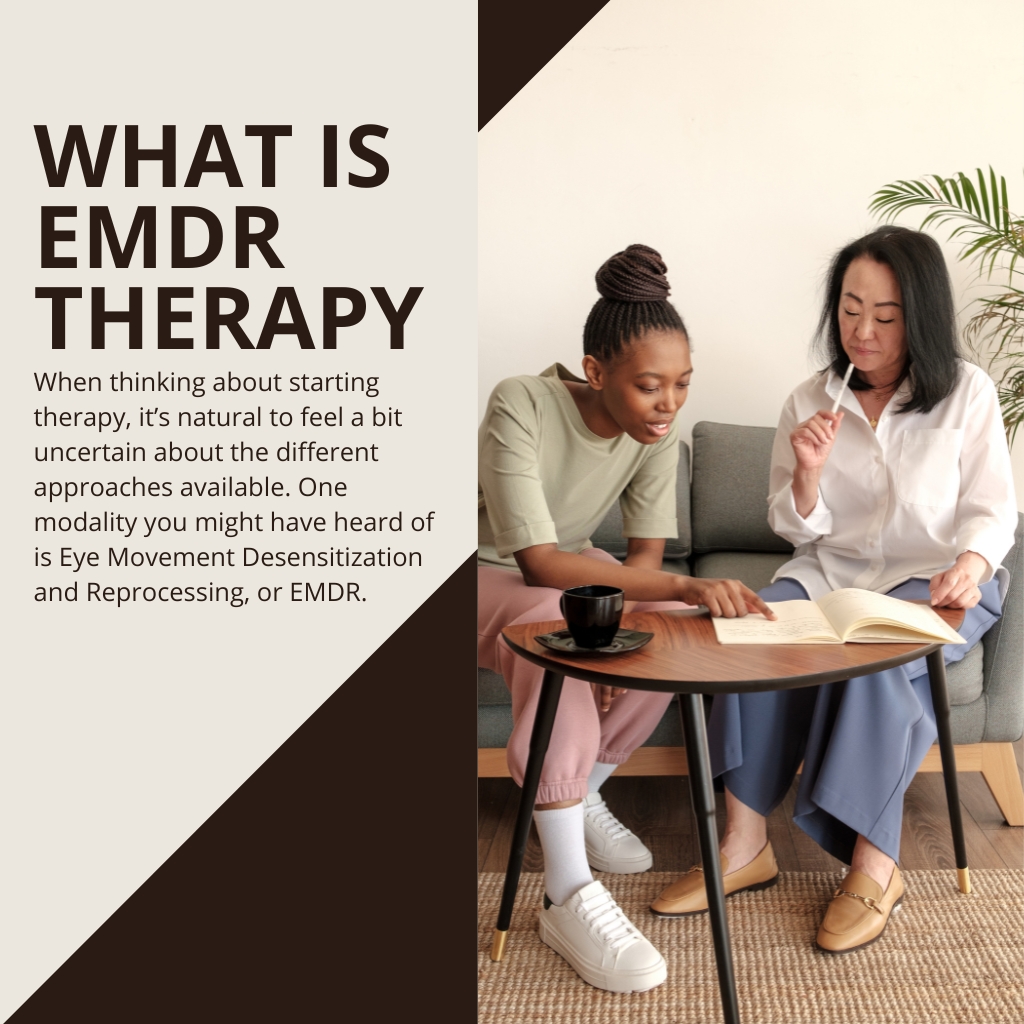Why emdr therapy new york city is trusted by therapists
The Process of EMDR Treatment: a Comprehensive Guide to Its Benefits and methods
EMDR treatment stands apart as an organized technique for resolving stressful memories. Its multi-phase method and unification of bilateral excitement strategies established it in addition to conventional treatments. By assisting in the reprocessing of traumatic experiences, EMDR provides an one-of-a-kind pathway to healing. What specific methods are employed, and what advantages do they give injury healing? Exploring these elements discloses a much deeper understanding of this reliable restorative alternative.
Understanding EMDR Therapy: A Review
EMDR treatment, or Eye Motion Desensitization and Reprocessing, is a psychotherapy method designed to relieve the distress connected with stressful memories. Created by Francine Shapiro in the late 1980s, EMDR incorporates aspects from numerous restorative modalities, including cognitive-behavioral therapy and psychodynamic therapy. The primary goal of EMDR is to help people procedure and reframe distressing memories, lowering their emotional fee and connected signs.
Throughout EMDR sessions, customers engage in dual attention stimuli, normally involving assisted eye motions, while recalling distressing memories - emdr therapy new york. This procedure permits the brain to reprocess the memory in a much healthier manner. EMDR has gained recognition for its efficiency in treating Clinical depression, anxiety, and ptsd, to name a few conditions. Study has actually shown that EMDR can lead to significant renovations in psychological wellness. As a structured treatment, it supplies an extensive structure for specialists to assist customers in getting over the influence of past traumas
The 8 Stages of EMDR
While lots of therapeutic approaches vary in framework and technique, the eight stages of EMDR provide a systematic structure that guides the healing process. These stages start with the history-taking and treatment planning, where the therapist collects pertinent information concerning the customer's experiences and establishes a risk-free atmosphere. The second phase concentrates on preparation, gearing up clients with devices to handle psychological distress.
In the third stage, clients identify specific memories to target. The 4th stage includes desensitization, where clients refine these memories while engaging in bilateral stimulation. The 5th stage emphasizes setup, reinforcing positive beliefs. The 6th phase addresses body scan methods to determine any residual tension.
The final two phases entail closure, returning customers to a state of equilibrium, and reevaluation, examining the effectiveness of the treatment. This organized technique guarantees that EMDR treatment is detailed, dealing with both the mental and physiological facets of trauma.
Key Techniques Utilized in EMDR Sessions
In EMDR sessions, specialists utilize details techniques to help with recovery and processing of stressful memories. Key among these are reciprocal stimulation approaches, which involve both hemispheres of the brain, and numerous memory processing strategies that help customers reframe their experiences. Understanding these methods is necessary for understanding the efficiency of EMDR treatment.
Bilateral Stimulation Techniques
Reciprocal stimulation methods are necessary methods utilized throughout EMDR sessions to facilitate the processing of terrible memories. These methods involve engaging both hemispheres of the brain, promoting combination and healing. Usual bilateral excitement methods include acoustic signs, such as rotating tones or sounds, and responsive stimulation, via the use of portable devices that produce alternating faucets. Visual stimuli, such as the therapist directing the customer's eye activities back and forth, are additionally widely utilized. The rhythmic nature of these strategies aids to activate the brain's all-natural handling capacities, permitting clients to recycle upsetting memories in a safe setting. Eventually, reciprocal stimulation fosters a feeling of safety and enhances the therapeutic experience during EMDR.
Memory Processing Methods
Memory handling methods in EMDR sessions are crucial for assisting customers confront and revamp traumatic experiences. These methods focus on promoting the reprocessing of traumatic memories, allowing customers to integrate and settle unfavorable feelings connected with them. One trick technique includes using bilateral stimulation, which can consist of tactile feelings or auditory tones, to improve the mind's info processing abilities. Throughout sessions, clients are directed to remember details memories while at the same time participating in bilateral stimulation, advertising a dual concentrate on the existing moment and the traumatic memory. This technique aids in decreasing the psychological charge of the memory, making it less invasive. Inevitably, memory processing methods equip clients to reconstruct their narratives, cultivating healing and strength.
The Function of Reciprocal Excitement
Bilateral excitement is a fundamental part of EMDR treatment, promoting the handling of terrible memories. Different techniques, such as auditory, responsive, and visual excitement, are used to involve both hemispheres of the brain. This approach has been revealed to boost trauma recuperation by promoting psychological law and minimizing distress related to past experiences.
System of Reciprocal Stimulation
The mechanism of bilateral excitement plays an important duty in assisting in the handling of traumatic memories when people involve in EMDR treatment. This strategy involves rotating excitement, commonly through auditory, tactile, or aesthetic ways, which triggers both hemispheres of the mind. The balanced nature of bilateral excitement is thought to resemble the mind's all-natural handling systems during rapid eye movement, promoting assimilation of stressful memories. As customers concentrate on their stressful experiences while concurrently participating in this stimulation, they may experience a decrease in emotional fee connected with those memories. This process allows for the reprocessing of injury, leading to boosted psychological regulation and a much more adaptive point of view on past events.
Kinds of Stimulation Techniques
Various link excitement methods are used in EMDR therapy to enhance the reprocessing of stressful memories. The main method is reciprocal stimulation, that includes auditory, visual, and tactile modalities. Auditory stimulation usually entails rotating noises played via headphones, while aesthetic stimulation can consist of assisted eye activities from side to side. Responsive stimulation may make use of handheld devices that produce rotating taps on the client's hands. Each of these methods intends to involve both hemispheres of the mind, promoting a more efficient processing of upsetting memories. Practitioners might choose one or a mix of these approaches based upon customer preferences and restorative objectives, ensuring an individualized strategy to recovery. These strategies are crucial for advertising a much deeper integration of stressful experiences within the restorative framework.
Advantages for Injury Healing
The role of bilateral stimulation in EMDR therapy substantially adds to trauma healing by helping with the processing of traumatic memories. This technique entails alternating sensory input, commonly via eye activities or auditory tones, which aids in integrating distressing experiences. By involving both hemispheres of the brain, reciprocal stimulation boosts emotional policy and decreases the strength of stressful memories. Research indicates that customers often experience a decline in anxiousness and a raised capability to confront traumatic thoughts. Furthermore, this approach advertises cognitive adaptability, enabling individuals to reframe their experiences in a much more flexible fashion. Ultimately, making use of bilateral stimulation in EMDR therapy plays an important function in enabling individuals to attain long-term healing and strength when faced with trauma.
The Science Behind EMDR: How It Functions
The precise mechanisms of Eye Movement Desensitization and Reprocessing (EMDR) treatment are still being checked out, research recommends that it helps with the processing of stressful memories by integrating sensory, psychological, and cognitive components. EMDR employs bilateral excitement, generally through led eye movements, which is thought to imitate the mind's natural handling during REM sleep. This excitement may help clients gain access to and recycle stressful memories, decreasing their emotional cost.
Neuroscientific researches suggest that EMDR may alter the means stressful memories are saved in the mind, advertising flexible resolution. The therapy urges people to face their memories and linked ideas, enabling them to reframe their experiences. In addition, the organized stages of EMDR-- such as installation, desensitization, and history-taking-- sustain a thorough exploration of the trauma, fostering assimilation of the fragmented elements of the memory. This procedure inevitably intends to recover a sense of balance and emotional health.
Advantages of EMDR for Injury Healing
EMDR treatment offers various advantages for people recovering from trauma, specifically by addressing the cognitive and emotional distortions linked with distressing experiences. One significant advantage is its ability to help with quick processing of traumatic memories, typically resulting in a decline in signs such as anxiousness and anxiety. This strategy allows customers to challenge their injury in a pop over here risk-free and structured setting, fostering durability and psychological policy.
In addition, EMDR assists individuals reframe negative ideas connected to their injury, advertising a healthier self-image and restoring a sense of control. The treatment can enhance general psychological wellness and empower clients to regain their lives, making it a beneficial tool in trauma recuperation. EMDR is ideal for numerous age teams and can be adapted to fulfill the details needs of people, making it a functional option for those seeking to heal from their stressful experiences effectively.
That Can Profit From EMDR Therapy?
People from varied backgrounds and experiences can gain from EMDR therapy, especially those that have experienced trauma in numerous kinds. This consists of survivors of youth abuse, all-natural disasters, mishaps, and battle experiences. Additionally, people struggling with post-traumatic stress condition (PTSD) typically locate EMDR to be an effective treatment option.
Past trauma, those taking care of stress and anxiety, anxiety, anxieties, and various other psychological health conditions may also experience improvements via EMDR. The therapy can aid in dealing with distressing memories that add to these problems.
Furthermore, EMDR is not restricted to grownups; teenagers and kids can likewise profit, especially when adapted to their developmental needs. In general, EMDR treatment offers a flexible technique, making it appropriate for a wide variety of individuals seeking recovery from psychological pain and emotional distress. Its structured yet flexible nature enables therapists to tailor the treatment to meet certain customer requirements.
Often Asked Concerns
Just how Long Does an EMDR Treatment Session Normally Last?

Is EMDR Treatment Appropriate for Children?
EMDR therapy can be appropriate for kids, as it has actually been adjusted to resolve their distinct developing needs. Properly educated specialists can successfully execute strategies that aid kids process terrible experiences in a helpful setting.
What Should I Anticipate After an EMDR Session?
After an EMDR session, people might YOURURL.com experience psychological launch, short-lived fatigue, or increased emotions. Some record improved clearness and relief, while others might feel a requirement for additional processing time to integrate their experiences effectively.
Are There Any Type Of Side Effects of EMDR Treatment?

Exactly how Do I Locate a Certified EMDR Specialist?
To discover a qualified EMDR specialist, individuals should look for recommendations from healthcare providers, validate credentials with specialist companies, and seek advice from online directory sites. Making certain proper training and experience in EMDR is important for reliable therapy.
Bilateral excitement is a basic component of EMDR treatment, facilitating the handling of distressing memories. When individuals involve in EMDR treatment, the system of reciprocal stimulation plays a vital function in assisting in the handling of stressful memories. Various stimulation methods are used in EMDR treatment to enhance the reprocessing of distressing memories. The role of bilateral excitement in EMDR treatment significantly adds to trauma recuperation by helping with the handling of stressful memories. The exact devices of Eye Movement Desensitization and Reprocessing (EMDR) treatment are still being checked out, research suggests that it assists in the processing of traumatic memories by incorporating sensory, psychological, and cognitive components.